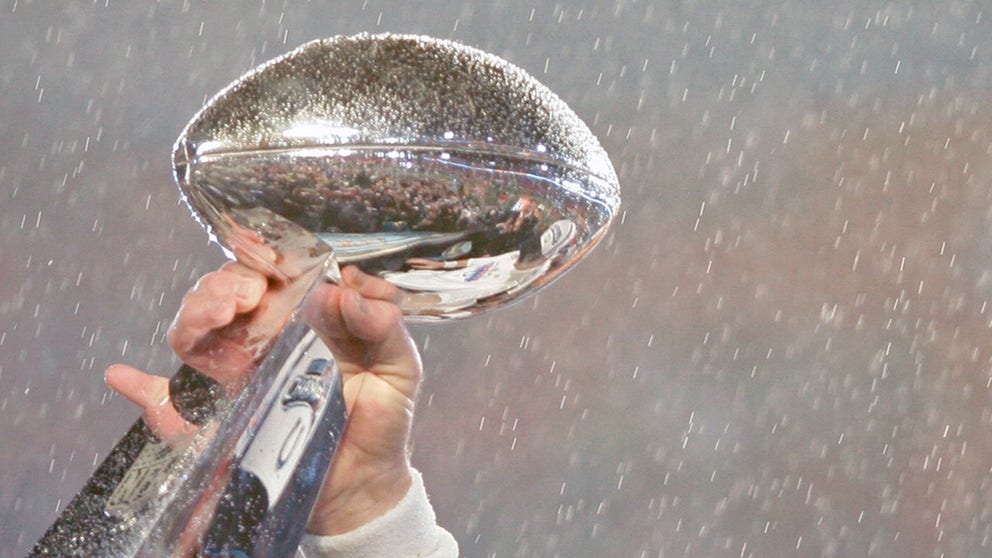From coldest to hottest: Here are the wildest Super Bowl weather moments in history
Despite efforts to protect the game from the elements, there have been instances where Super Bowl conditions have been less than ideal.
Seven Super Bowl Weather Superlatives
Despite efforts to protect the game from the elements, there have been instances where the Super Bowl conditions have been less than ideal.
Weather is a significant factor when the NFL selects which city's stadium will host the Super Bowl. When the champions of the American and National football conferences battle it out for the sport's most coveted trophy, the NFL makes an effort to ensure that they do so with perfect conditions.
Traditionally when selecting a host city, the NFL will award the big game to a stadium located in a city with an expected average daily temperature above 50 degrees on game day. The exception is when a roof can cover the stadium. The warm climates of Miami, New Orleans and Los Angeles have hosted 29 of 57 Super Bowls.
However, despite efforts to protect the game from the elements, there have been instances where the Super Bowl was played in conditions that were less than ideal.
The coldest Super Bowl
Super Bowl VI – Jan. 16, 1972 – New Orleans, Louisiana

Football: Super Bowl VI: Dallas Cowboys QB Roger Staubach (12) in acion vs Miami Dolphins at Tulane Stadium. New Orleans, LA 1/16/1972
(Walter Iooss Jr. /Sports Illustrated / Getty Images)
Historically, the average temperature on Jan. 16 in New Orleans is 60 degrees. However, when the Dallas Cowboys and Miami Dolphins met at Tulane Stadium, it was a cold 39 degrees with a wind chill in the 20s.
The cold weather did not slow down the hot Cowboys' running game, which accumulated 252 yards en route to a dominant 24-3 victory. The win certainly warmed the hearts of Cowboys fans who were still disappointed about losing the previous year's Super Bowl on a last-minute field goal.
Super Bowl VI was the last outdoor Super Bowl played in New Orleans. The Superdome has hosted all subsequent big games in the Big Easy.
The windiest Super Bowl
Super Bowl XIV – Jan. 20, 1980 – Pasadena, California
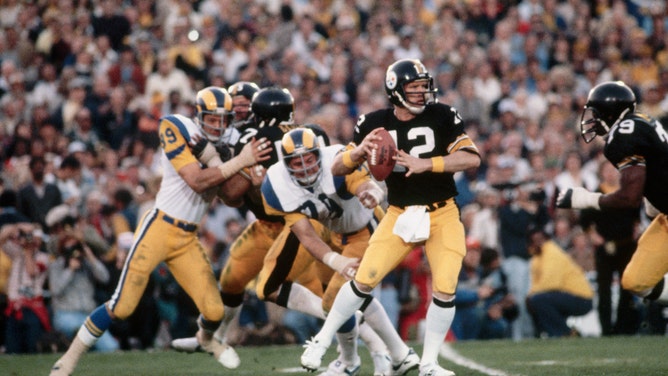
The Steelers and Rams in the 1980 Superbowl.
(Wally McNamee/CORBIS/Corbis / Getty Images)
The last time the Los Angeles Rams played a Super Bowl in their home city, they had to contend with the Pittsburgh Steelers and 30-mph wind gusts.
The underdog Rams carried a two-point lead into the fourth quarter and appeared to be on the verge of an upset. However, the Steelers team, which had claimed three of the previous five Super Bowls, scored two fourth-quarter touchdowns to pull away and win 31-19.
The next time the Rams would play in a Super Bowl was 20 years later as the St. Louis Rams. The Rams are one of only three franchises to play in the Super Bowl, representing two different cities. The other two are the Colts (Baltimore, Indianapolis) and the Raiders (Los Angeles, Oakland).
The snowiest Super Bowl
Super Bowl XL – Feb. 5, 2006 – Detroit, Michigan
Detroit was a winter wonderland when it hosted Super Bowl XL in 2006. An inch of snow fell on the city as the Pittsburgh Steelers and Seattle Seahawks prepared to battle it out for the Lombardi Trophy.
Fortunately for the players and fans, the game was played on Ford Field inside a climate-controlled dome with the thermostat set to 68 degrees. The toasty indoor atmosphere was the only bit of good fortune the Seahawks would receive on this Super Sunday. With the help of a few tough breaks and controversial calls, the Seahawks fell to the Steelers 21-10.
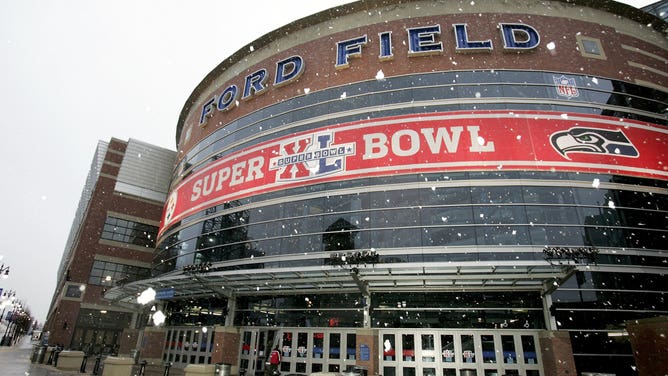
DETROIT - FEBRUARY 04: Snow falls outside Ford Field the day before Super Bowl XL on February 4, 2006 in Detroit, Michigan.
(Jonathan Ferrey / Getty Images)
The conditions of this game echoed those of Super Bowl XVI played in nearby Pontiac, Michigan. While the San Francisco 49ers were beating the Cincinnati Bengals 26-21, a little less than an inch of snow fell on the bitterly cold city. Players and fans were kept warm by the Pontiac Silverdome during that game.
Super Bowl XLVIII in 2014 was the closest we've come to seeing snowy conditions on the field during a Super Bowl. For this game, the NFL bucked their trend of awarding an outdoor game to a traditionally warm-weather city. To the surprise of everyone, East Rutherford, New Jersey, was unseasonably warm at kickoff, with a temperature of 49 degrees. The following day was a different story, as 8 inches of snow fell on MetLife Stadium. Perhaps the dynamic play of the Seattle Seahawks in their 43-8 rout of the Denver Broncos is what kept the air so warm on game day.
The messiest Super Bowl
Super Bowl XXXIV – Jan. 30, 2000 – Atlanta, Georgia
While the Tennessee Titans and St. Louis Rams played inside the comfy confines of the Georgia Dome, an ice storm that made travel around the city a nightmare plagued Atlanta. Titans fans were dealt a nightmare of their own as Kevin Dyson came up just a yard short of tying the game as time expired, giving the Rams their first-ever Super Bowl victory 23-16.
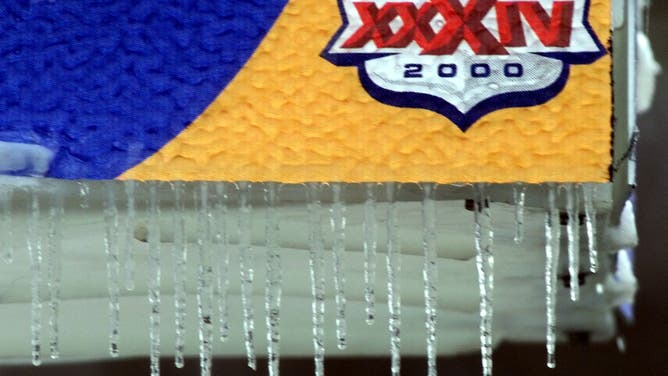
Icicles hang from a sign 29 January,2000 outside the the Georgia Dome in Atlanta, Georgia the site of Super Bowl XXXIV.
(JEFF HAYNES/AFP / Getty Images)
Super Bowl XLV, played at Cowboys Stadium in Arlington, Texas, was also plagued by wintry weather the week leading up to the big game. Three days before the Green Bay Packers took on the Pittsburgh Steelers, a winter storm hit the Dallas-Fort Worth metro area and covered Cowboys Stadium with snow and ice. The following day, snow and ice slid off the stadium's roof, injuring six people working to prepare for the game.
The game went on as scheduled, and the Packers defeated the Steelers 31-25.
The wettest Super Bowl
Super Bowl XLI – Feb. 4, 2007 – Miami, Florida
Super Bowl XLI likely had the most unpleasant conditions of any Super Bowl to date, with torrential rain falling throughout the game. The teams combined for six fumbles and eight total turnovers largely because of the wet and windy conditions.
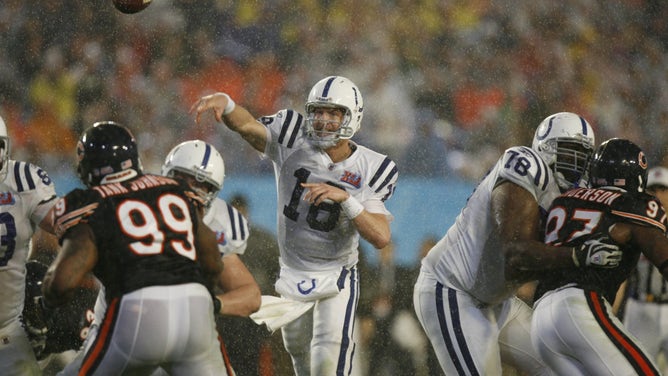
UNITED STATES - FEBRUARY 04: Football: Super Bowl XLI, Indianapolis Colts QB Peyton Manning (18) in action, making pass vs Chicago Bears, Rain, weather, Miami, FL 2/4/2007
(Al Tielemans/Sports Illustrated / Getty Images)
The Indianapolis Colts overcame the sloppy conditions and defeated the Chicago Bears 29-17.
Though the wet weather created an ugly football game, it was the perfect backdrop for Prince's halftime performance of "Purple Rain."
The darkest Super Bowl
Super Bowl XLVII – Feb. 3, 2013 – New Orleans, Louisiana
The Mercedes-Benz Superdome in New Orleans, Louisiana, kept Super Bowl XLVII safe from the elements. After a rousing halftime performance by Beyonce, the Ravens instantly increased their lead to 28-6 thanks to a 108-yard Jacoby Jones kickoff return.
Then, something strange happened. With 13:22 remaining in the third quarter, darkness covered half of the stadium. The Superdome had partially lost power.

Joe Flacco #5 of the Baltimore Ravens looks on during the power outage in the third quarter during Super Bowl XLVII against the San Francisco 49ers on February 3, 2013 in New Orleans,
(Rob Tringali/SportsChrome / Getty Images)
After the power shut off, any unfortunate fans in an elevator found themselves trapped. Fans sat under the emergency lighting, trying to find answers to why this was happening on their smartphones.
Eventually, the cause of the blackout was determined to be the failure of a device meant to protect the power supply to the Superdome. After a 34-minute delay, the game was able to resume.
The lights coming back on seemed to light up the 49ers' offense as they staged a monster comeback, cutting the lead to 31-29 with 9:57 to go. However, the Ravens never relinquished their lead and won their second Super Bowl in franchise history 34-31.
The Superdome has not hosted another Super Bowl since the blackout but is scheduled to host Super Bowl LIX in 2025.
The hottest Super Bowl
Super Bowl VII – Jan. 14, 1973 – Los Angeles, California
The only thing hotter than the Miami Dolphins at the start of Super Bowl VII was the weather. The Dolphins entered the game 16-0, attempting to become the first undefeated Super Bowl champion in NFL history. The temperature at kickoff in the Los Angeles Coliseum was 84 degrees.
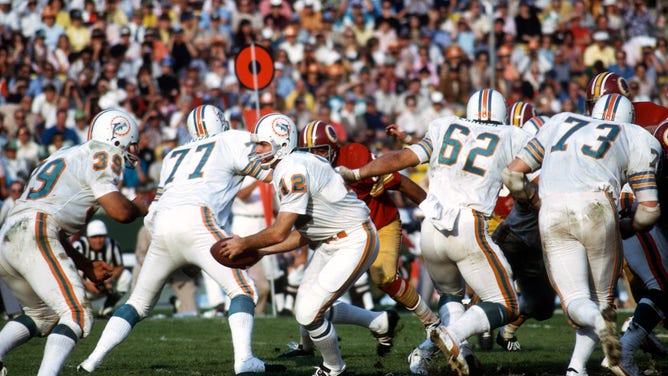
Bob Griese #12 of the Miami Dolphins turns to hand the ball off to running back Larry Csonka #9 against the Washington Redskins during Super Bowl VII at the Los Angeles Memorial Coliseum in Los Angeles, California, January 14, 1973.
(Focus on Sport / Getty Images)
The Dolphins completed the only perfect season in the Super Bowl era by beating both the heat and Washington.
This record was rivaled on Feb. 13, 2022, when Super Bowl LVI was played at SoFi Stadium in Inglewood, California. Although Los Angeles International Airport (LAX) set a new daily record high of 85 degrees that day, the temperature at the stadium (82 degrees at kickoff) stayed just below the game-time record set in 1973
